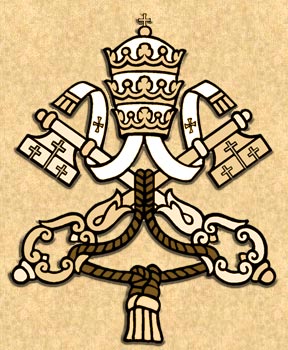
There are in Rome three patriarchal churches in which, on different feast days, the Pope officiates. These are the Basilicas of Saint Peter on the Vatican Hill, Saint John Lateran, and Saint Mary Major on the Esquiline Hill. The last-named, the Liberian Basilica, was founded in the time of Pope Liberius, in the fourth century; it was consecrated to the Virgin Mary by Sixtus III in the year 435, under the title of Saint Mary ad Nives, or at the snow, because the Mother of God Herself chose, and indicated by a miracle, its site to be that of Her first church in Rome.
In the fourth century a patrician by the name of John and his pious spouse had no children; already advanced in age and without heirs, they resolved to consecrate their wealth to the Most Blessed Virgin. They prayed in order to know how the Queen of Heaven would like them to use their fortune. On August 5, 366, She appeared to each of them in a dream and told them that Her Divine Son’s and Her own will was that their wealth be employed in the construction of a church on Mount Esquiline, at a place which in the morning they would find covered with snow. They consulted together when the dawn broke, and went to the Pope at once to tell him what God had made known to them. He himself had had a similar dream and could not doubt that this was a celestial prodigy. He assembled the clergy and people, and all went in procession towards the indicated place, to verify the reality of the marvel. When they arrived on the hilltop, they saw an area covered with snow, extending over a space sufficient to build a vast church. It was built at the expense of the noble couple with great magnificence, and given the name of Saint Mary of the Snows.
The same Basilica is sometimes entitled Saint Mary ad Praesepe, of the Manger, from the holy crib or manger of Bethlehem, in which the Infant Jesus was laid at His birth. It was transported to Rome and kept in a sumptuous subterranean chapel of the church. Today this Basilica bears the name of Saint Mary Major, because it is, both by its beauty and its antiquity, the first of the numerous Roman churches dedicated to Mary.
In the fourth century a patrician by the name of John and his pious spouse had no children; already advanced in age and without heirs, they resolved to consecrate their wealth to the Most Blessed Virgin. They prayed in order to know how the Queen of Heaven would like them to use their fortune. On August 5, 366, She appeared to each of them in a dream and told them that Her Divine Son’s and Her own will was that their wealth be employed in the construction of a church on Mount Esquiline, at a place which in the morning they would find covered with snow. They consulted together when the dawn broke, and went to the Pope at once to tell him what God had made known to them. He himself had had a similar dream and could not doubt that this was a celestial prodigy. He assembled the clergy and people, and all went in procession towards the indicated place, to verify the reality of the marvel. When they arrived on the hilltop, they saw an area covered with snow, extending over a space sufficient to build a vast church. It was built at the expense of the noble couple with great magnificence, and given the name of Saint Mary of the Snows.
The same Basilica is sometimes entitled Saint Mary ad Praesepe, of the Manger, from the holy crib or manger of Bethlehem, in which the Infant Jesus was laid at His birth. It was transported to Rome and kept in a sumptuous subterranean chapel of the church. Today this Basilica bears the name of Saint Mary Major, because it is, both by its beauty and its antiquity, the first of the numerous Roman churches dedicated to Mary.










No comments:
Post a Comment